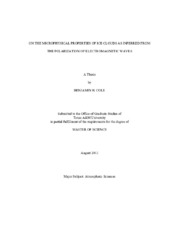| dc.description.abstract | Uncertainties associated with the microphysical and radiative properties of ice clouds remain an active research area because of the importance these clouds have in atmospheric radiative transfer problems and the energy balance of the Earth. In this study, an adding/doubling model is used to simulate the top of atmosphere (TOA) radiance and full Stokes vector from an ice cloud at the wavelength lambda = 865 nm with many different combinations of assumed ice habits (shapes) and different degrees of ice surface roughness, and the polarized radiance at a wide range of scattering angles is derived. Simulated results are compared with polarized radiance data from the POLDER (POLarization and Directionality of the Earth's Reflectances) instrument on board the PARASOL (Polarization and Anisotropy of Reflectances for Atmospheric Sciences coupled with Observations from a Lidar) satellite.
Bulk ice scattering properties are obtained by using five different size distributions collected during field campaigns ranging in effective diameter from 10 micrometers to 90 micrometers. Bulk scattering properties for the MODIS Collection 5 ice cloud product are used in this study, along with properties for two mid-latitude ice cloud models, a polar/mid-latitude ice model, and a model built for ice clouds over deep convection. Solid columns and hollow columns are used as well.
The polarized radiance simulation results for the moderate surface roughness level best fit the satellite measurements for all ice models, though severely roughened ice crystals do fare well in a few cases. Hollow columns are the best fit to the satellite polarization measurements, but of the ensemble ice models, the polar/mid-latitude model at an effective diameter of 90 micrometers best fits the polarized radiance measurements for the one day of PARASOL data considered. This model should be the best to simulate ice cloud properties on a global scale. | en |


